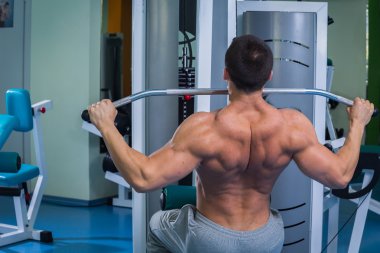
Can You Do Chest And Back Exercises Together (8 Helpful Guidelines)
Can you do chest and back exercises together in a single workout session? Combining these exercises can be an efficient way to maximize your training time and enhance muscle balance. This approach not only saves time but also promotes overall upper body strength and symmetry.
Imagine sculpting a physique that commands attention, boasting both a powerful chest and a V-shaped back—all in the same workout session. The synergy of combining chest and back exercises isn’t just efficient; it’s a game-changer that can amplify muscle growth, enhance functional strength, and redefine your fitness routine. This dynamic duo engages complementary muscle groups, ensuring balanced development and a more intense, calorie-burning workout. Ready to unlock the secrets of this powerhouse pairing? Let’s dive into why training chest and back together could be your ultimate fitness hack.

Can You Do Chest And Back Exercises Together
Yes, you can do chest and back exercises together in a single workout session. This approach is efficient, promotes muscle balance, and maximizes workout time. Training these opposing muscle groups together enhances strength, muscle growth, and overall fitness. Incorporating compound movements boosts metabolism and improves posture.
Benefits of Chest and Back Training Together
Combining chest and back exercises in one session offers several benefits. First, it creates a balanced physique, reducing the risk of muscular imbalances. When you work your chest with exercises like bench presses and push-ups, you engage pushing muscles. Pairing these with back exercises like pull-ups and rows engages pulling muscles, ensuring comprehensive upper body strength. Additionally, alternating between these exercises can reduce workout time by allowing one muscle group to recover while the other works. This method increases workout intensity and efficiency.
Effective Chest and Back Exercises
For a well-rounded workout, include compound movements that target both muscle groups. Classic chest exercises include bench presses, incline presses, and push-ups. These exercises build the pectoral muscles, front deltoids, and triceps. For the back, incorporate pull-ups, bent-over rows, and deadlifts. These movements target the latissimus dorsi, rhomboids, and trapezius muscles. Combining these exercises in a superset format, where you alternate between chest and back exercises with minimal rest, can enhance muscle hypertrophy and cardiovascular endurance.
Structuring Your Workout
A typical chest and back workout could look like this: Start with a warm-up to prepare your muscles and joints. Begin with a bench press set, followed by a set of pull-ups. Continue this pattern with exercises such as incline dumbbell presses paired with bent-over rows, and finish with push-ups alternated with dumbbell deadlifts. Aim for 3-4 sets of each exercise with 8-12 repetitions per set. Ensure you maintain proper form to prevent injuries and maximize muscle activation.
Post-Workout Recovery and Tips
Post-workout recovery is crucial for muscle growth and repair. After your chest and back workout, incorporate a cool-down session with stretching to enhance flexibility and reduce muscle soreness. Adequate nutrition, including protein intake, helps repair and build muscle tissue. Hydration and sufficient rest are also vital. Listen to your body and adjust the intensity and volume of your workouts to match your fitness level and goals.
Benefits of Combining Chest and Back Exercises
Time Efficiency
Combining chest and back exercises in a single workout session offers significant benefits, particularly in terms of time efficiency. By targeting both major muscle groups simultaneously, individuals can reduce the number of workout sessions needed per week, allowing for more rest days or the opportunity to focus on other fitness aspects.
Additionally, this approach promotes balanced muscle development, as the chest and back muscles are worked in tandem, ensuring proportional strength and growth. This balanced development not only enhances overall physical aesthetics but also supports better posture and reduces the risk of muscular imbalances that can lead to injuries. Thus, integrating chest and back exercises in one session maximizes workout productivity and fosters a more harmonious physique.
Increased Caloric Burn
Engaging both of these large muscle groups simultaneously results in a higher overall energy expenditure during the workout. Chest exercises such as bench presses, push-ups, and chest flyes, when paired with back exercises like rows, pull-ups, and deadlifts, activate a considerable amount of muscle mass. This extensive muscle activation demands more energy, thereby burning more calories both during and after the exercise session.
Additionally, the intensity and complexity of working opposing muscle groups enhance the metabolic rate post-workout, a phenomenon known as excess post-exercise oxygen consumption (EPOC). This elevated metabolic state ensures that the body continues to burn calories at an accelerated rate even after the workout has concluded, contributing to more effective fat loss and overall improved cardiovascular health.
Enhanced Muscular Balance
Combining chest and back exercises in your workout routine offers significant benefits, particularly in enhancing muscular balance. By targeting opposing muscle groups, you can prevent muscular imbalances that often result from focusing too heavily on one area, such as only doing chest presses without corresponding back exercises. This balanced approach ensures that both the anterior (front) and posterior (back) muscles develop evenly, promoting a symmetrical physique.
Additionally, working these muscle groups together can improve overall strength and stability, as many exercises for the chest and back engage the core and other stabilizing muscles. This holistic development not only enhances aesthetic appeal but also reduces the risk of injuries related to muscle imbalances, thereby supporting better posture and functional movement in daily activities.
Improved Cardiovascular Fitness
Combining chest and back exercises in a single workout session offers substantial benefits for improving cardiovascular fitness. The high-intensity nature of these combined workouts ensures that both muscle groups are engaged simultaneously or in quick succession, leading to a significant increase in heart rate. This heightened cardiovascular demand not only enhances heart health but also boosts overall endurance.
The continuous switching between chest and back exercises prevents prolonged rest periods, maintaining an elevated heart rate throughout the session. This sustained intensity mimics the effects of interval training, promoting better oxygen utilization and increasing the efficiency of the cardiovascular system. Additionally, this approach can lead to greater caloric burn and improved metabolic rate, further contributing to cardiovascular health and overall fitness levels.

Drawbacks of Combining Chest and Back Exercises
Potential for Overtraining
Combining chest and back exercises in a single workout can present several drawbacks, primarily due to the potential for overtraining. The chest and back are both large muscle groups that, when trained together, place significant demands on the central nervous system (CNS). This intense strain can lead to CNS fatigue, reducing overall workout efficiency and increasing the risk of improper form or injury.
Moreover, the high volume of work required to adequately train both muscle groups can extend workout duration, further taxing the body’s energy reserves and recovery capacity. Insufficient recovery time between sessions can impair muscle growth and repair, leading to plateaued progress or even regression. Additionally, the cumulative fatigue from back-to-back intense sessions can heighten the risk of overuse injuries, such as strains and tendonitis, particularly if the workouts are not well-structured or if proper technique is compromised. Balancing the demands on the CNS and ensuring adequate recovery time are crucial to optimizing performance and minimizing the risks associated with overtraining.
Risk of Injury
Combining chest and back exercises in a single workout session can significantly elevate the risk of injury, primarily due to the compounded fatigue that can result in poor form. When the chest and back muscles are both engaged intensively, the overall energy expenditure and muscle fatigue are considerable. This fatigue can impair proper exercise execution, leading to suboptimal form and technique.
Consequently, there is a higher likelihood of muscle strains, especially in the shoulder and upper back areas, which are common points of stress during chest and back exercises. Additionally, joint issues can arise from the excessive load and repeated strain on the same joints, particularly the shoulder and spine. The cumulative effect of these factors increases the potential for acute injuries like tears or chronic issues such as tendonitis, emphasizing the need for careful planning and sufficient recovery time when structuring a workout regimen that includes both muscle groups.
Complexity of Workout Planning
Combining chest and back exercises in a single workout session presents several challenges, primarily due to the complexity of workout planning. Firstly, it necessitates careful exercise selection and sequencing to ensure that both muscle groups are adequately targeted without overlapping too much, which could compromise the effectiveness of the exercises. For instance, exercises like bench presses and rows, which are staples for chest and back workouts respectively, must be strategically placed to maintain high performance levels throughout the session.
Secondly, there’s a need to ensure a balanced workload to prevent excessive fatigue. Both the chest and back are large muscle groups that require significant energy and recovery time. If not properly managed, combining them can lead to an uneven distribution of effort, resulting in one muscle group being overworked while the other is under-stimulated. This imbalance not only hampers muscle growth and strength development but also increases the risk of injury. Thus, meticulous planning is crucial to achieve optimal results and maintain overall muscular health when combining chest and back exercises.
Scientific Basis for Combining Chest and Back Workouts
Muscle Fiber Recruitment
Combining chest and back workout in a single session can significantly enhance muscle development by optimizing muscle fiber recruitment. The chest muscles, primarily the pectorals, are composed of a higher proportion of fast-twitch muscle fibers, which are capable of generating powerful, explosive movements. In contrast, the back muscles, including the latissimus dorsi and trapezius, contain a mix of both fast-twitch and slow-twitch fibers. Slow-twitch fibers are more fatigue-resistant and are essential for endurance and sustained contractions.
By targeting both muscle groups in a single workout, a broader range of muscle fibers are engaged, promoting balanced strength and hypertrophy. This approach also stimulates a greater overall metabolic response, as the body works harder to repair and build different types of muscle fibers. The alternating use of pushing and pulling movements can enhance neural adaptations and improve muscle coordination, leading to more effective and efficient workouts. Thus, incorporating both chest and back exercises in one session not only maximizes muscle fiber recruitment but also ensures comprehensive muscular development and improved performance.
Hormonal Response
Combining chest and back workouts within a single session offers a scientifically grounded approach to optimizing muscle growth and overall fitness. One key aspect driving this effectiveness lies in the hormonal response triggered by such compound movements. During exercises targeting the chest and back, the body releases anabolic hormones such as testosterone and growth hormone, both crucial for muscle development and recovery.
Testosterone, known for its role in promoting muscle protein synthesis, is stimulated by multi-joint exercises like bench presses and rows. These movements engage large muscle groups simultaneously, leading to a greater release of testosterone compared to isolated exercises. Similarly, growth hormone secretion is heightened during compound exercises due to the increased metabolic demand and muscle fiber recruitment, fostering muscle repair and growth. By strategically combining chest and back workouts, individuals can capitalize on this hormonal surge, fostering optimal conditions for muscle hypertrophy and overall strength gains.
Designing an Effective Chest and Back Workout
Warm-up and Stretching
Designing an effective chest and back workout begins with a solid foundation: warm-up and stretching. This crucial step primes the muscles and joints for the intense activity ahead, reducing the risk of injury and enhancing performance. Understanding the importance of this phase is key; it increases blood flow to the muscles, improves flexibility, and mentally prepares you for the workout.
Incorporating dynamic stretches such as arm circles, shoulder rolls, and torso twists helps to loosen up tight muscles and increase range of motion. Light cardio activities like jogging or jumping jacks elevate the heart rate, further warming up the body and ensuring it’s ready for the workload ahead. By prioritizing a thorough warm-up and stretching routine, you set the stage for a safe, effective, and rewarding chest and back workout session.
Exercise Selection
Compound movements such as bench presses and deadlifts engage multiple muscle groups simultaneously, making them efficient choices for building overall strength and muscle mass. These exercises not only target the chest and back but also engage secondary muscles, promoting functional strength and coordination.
Additionally, isolation exercises like chest flyes and bent-over rows allow for targeted muscle activation, helping to refine muscle definition and address any muscular imbalances. By integrating both compound and isolation exercises into your routine, you can ensure comprehensive stimulation of the chest and back muscles, leading to balanced development and enhanced performance.
Workout Structure
A balanced regimen typically incorporates a variety of exercises targeting different muscle groups within these areas. Integrating supersets and circuit training options can enhance efficiency and intensity. By pairing complementary exercises, such as bench presses with bent-over rows or push-ups with pull-ups, you engage multiple muscle groups while maximizing time and effort.
Additionally, alternating between chest and back exercises within a circuit format not only provides a comprehensive workout but also keeps the heart rate up, promoting cardiovascular health and calorie burn. It’s crucial to maintain a balance between volume and intensity to prevent overtraining and ensure sufficient recovery. This balance involves selecting appropriate weights and repetitions that challenge muscles without sacrificing proper form. Incorporating both heavy compound movements and lighter isolation exercises can help achieve a well-rounded workout that builds strength, endurance, and muscle definition in the chest and back regions.
Cool-down and Recovery
Designing an effective chest and back workout involves a strategic combination of exercises targeting these muscle groups while considering factors like intensity, volume, and proper form. Prioritizing compound movements like bench presses, rows, and pull-ups ensures comprehensive muscle engagement. Integrating variations such as incline or decline presses and wide or narrow grip rows adds depth to the workout, stimulating different muscle fibers for balanced development.
Implementing supersets or circuits can maximize efficiency and intensity, while allowing adequate rest between sets maintains quality reps. After the workout, post-workout stretching emerges as a crucial element to aid muscle recovery and flexibility. Engaging in dynamic stretches targeting the chest and back muscles helps alleviate tightness and reduce the risk of injury.
Additionally, incorporating recovery techniques like foam rolling facilitates myofascial release, easing muscle tension and enhancing blood circulation. Staying adequately hydrated supports optimal muscle function and aids in flushing out toxins post-exercise, contributing to faster recovery. By integrating these practices into the workout routine, individuals can optimize their chest and back training while prioritizing cool-down and recovery for long-term progress and injury prevention.

Sample Chest and Back Workout Routine
Beginner Routine
For beginners looking to sculpt a stronger chest and back, this sample workout routine provides a solid foundation. It kicks off with a crucial 10-minute warm-up, engaging in light cardio to get the blood flowing and muscles primed. Then, it delves into a series of exercises targeting key muscle groups. The routine incorporates classic moves like the bench press to build chest strength and bent-over rows for a powerful back.
Push-ups and pull-ups are included to further challenge and engage these areas. Chest flyes and dumbbell rows add variety and ensure a well-rounded workout. Each exercise is structured into three sets, aiming for muscle endurance and development. Finally, a 10-minute cool-down wraps up the session with essential stretching, aiding in muscle recovery and flexibility enhancement. This routine offers a balanced approach for beginners, laying the groundwork for progress and growth in both chest and back strength.
Advanced Routine
The advanced sample chest and back workout routine begins with a comprehensive warm-up session, emphasizing 15 minutes of dynamic stretching and mobility exercises to prepare the muscles and joints for the intense workout ahead. Moving into the core of the routine, the exercises are strategically chosen to target the chest and back muscles from various angles, ensuring a well-rounded development.
Starting with incline bench press, the routine focuses on strength and hypertrophy with 4 sets of 8 reps, followed by deadlifts for overall back development. Cable crossovers are incorporated to isolate and shape the chest muscles, complemented by T-bar rows to engage the back muscles deeply. Dips add a calisthenic element to the routine, enhancing overall upper body strength with 3 sets of 15 reps. The routine is then rounded off with single-arm dumbbell rows, providing unilateral stimulation to the back muscles for balanced development.
Finally, a thorough cool-down session comprising 15 minutes of stretching and foam rolling is included to aid in muscle recovery and prevent post-workout stiffness. This advanced routine is designed to challenge the chest and back muscles effectively, promoting strength, size, and definition.
Practical Tips for Combining Chest and Back Workouts
Listen to Your Body
Combining chest and back workouts can be highly effective for building a balanced upper body, but it is crucial to listen to your body to avoid overtraining. Recognize signs such as prolonged muscle soreness, fatigue, decreased performance, and elevated resting heart rate, which may indicate that you are pushing too hard.
Adjust the intensity and volume of your workouts based on your recovery needs; ensure you incorporate rest days and lighter sessions to allow your muscles to repair and grow. Proper warm-ups, cool-downs, and adequate hydration and nutrition also play vital roles in maintaining optimal performance and recovery. By tuning into your body’s signals and making necessary adjustments, you can maximize the benefits of combined chest and back workouts while minimizing the risk of injury and burnout.
Focus on Form and Technique
Combining chest and back workouts can be highly effective, but it’s crucial to prioritize form and technique to maximize benefits and prevent injuries. Proper form ensures that the targeted muscles are engaged correctly, enhancing muscle growth and strength. For chest exercises like bench presses and push-ups, maintain a neutral spine, keep the core engaged, and avoid flaring the elbows too wide.
In back exercises such as pull-ups and rows, focus on retracting the shoulder blades and maintaining a straight back. To avoid injury, start with lighter weights to perfect your form before progressing to heavier loads. Incorporate a thorough warm-up to increase blood flow and flexibility, and always listen to your body, stopping if you feel any sharp pain. By prioritizing form and technique, you ensure a safe and effective chest and back workout.
Nutrition and Hydration
Combining chest and back workouts effectively requires not only strategic exercise planning but also attention to nutrition and hydration. Pre-workout nutrition should focus on consuming a balanced meal that includes carbohydrates and protein about 2-3 hours before exercising to ensure adequate energy and muscle support. A smaller snack, such as a banana or a protein shake, 30-60 minutes before the workout can provide an extra energy boost.
Post-workout nutrition is crucial for recovery; consuming a meal rich in protein and carbohydrates within 30-60 minutes after exercising helps replenish glycogen stores and repair muscle tissue. Hydration is equally important; drinking water before, during, and after the workout prevents dehydration, which can impair performance and recovery. Staying hydrated supports optimal muscle function and helps in the efficient transportation of nutrients throughout the body.
Rest and Recovery
Combining chest and back workouts can be highly effective for building upper body strength and improving muscular balance, but it is essential to integrate proper rest and recovery strategies to maximize benefits and prevent injury. Rest days are crucial as they allow muscles to repair and grow, reducing the risk of overtraining and ensuring optimal performance in subsequent workouts.
Incorporating active recovery techniques, such as light cardio, yoga, or stretching, can enhance blood flow to the muscles, alleviate stiffness, and expedite the recovery process without imposing additional strain. Balancing intense training with adequate rest and active recovery not only fosters better results but also supports long-term fitness sustainability and overall well-being.
Alternatives to Combined Workouts
Traditional Split Routines
Alternatives to traditional split routines, such as the chest and triceps or back and biceps splits, include full-body workouts, upper/lower splits, and push/pull/legs routines. Full-body workouts engage all major muscle groups in each session, making them efficient for those with limited time, and promoting balanced muscle development.
Upper/lower splits divide workouts into upper body and lower body days, allowing for more focused and intense training of each muscle group. Push/pull/legs routines, which separate workouts into pushing movements (chest, shoulders, triceps), pulling movements (back, biceps), and leg exercises, offer a balanced approach that optimizes recovery and muscle growth. These alternatives cater to different training goals and schedules, providing flexibility and variety in workout regimens.
Push-Pull Workouts
Push-pull workouts are an effective alternative to combined workouts, focusing on either pushing or pulling movements in a single session. This structure splits exercises into two categories: push workouts that target muscles used in pushing actions (like the chest, shoulders, and triceps) and pull workouts that engage muscles involved in pulling actions (such as the back and biceps).
One significant benefit of this approach is that it allows for more focused muscle group training, promoting balanced muscle development and reducing the risk of overtraining. Additionally, it can lead to improved muscle recovery since opposing muscle groups are worked on different days. However, one drawback is that push-pull workouts might require more frequent gym sessions compared to combined workouts, as they typically split routines into more days to cover all muscle groups effectively. This could be challenging for individuals with limited time availability.

Full-Body Workouts
Alternatives to combined workouts, such as full-body workouts, offer distinct advantages, particularly in terms of frequency and structure. Full-body workouts typically involve engaging multiple muscle groups in a single session, which can be scheduled two to three times per week. This approach allows for ample recovery time while ensuring that all major muscle groups are trained consistently. The structure of full-body workouts often includes compound exercises like squats, deadlifts, and bench presses, which efficiently target multiple muscles simultaneously, making the most of each workout session.
Full-body workouts are highly suitable for various fitness levels. Beginners can benefit from the comprehensive nature of these workouts, promoting balanced strength development and overall fitness. Advanced athletes can also find full-body routines advantageous as they provide a time-efficient way to maintain and enhance muscle mass and functional strength. This versatility makes full-body workouts an excellent alternative for those seeking a balanced and effective exercise regimen.
FAQ: Can You Do Chest And Back Exercises Together
Q1. Can you do chest and back exercises together in the same workout?
A. Yes, you can combine chest and back exercises in the same workout. This is often referred to as a “push-pull” workout, where chest exercises primarily involve pushing movements and back exercises involve pulling movements. This approach can be effective for balancing muscle development and improving overall strength.
Q2. What are the benefits of training chest and back together?
A. Training chest and back together offers several benefits:
Balanced Muscle Development: Working opposing muscle groups helps prevent imbalances and promotes symmetrical strength.
Increased Efficiency: Combining chest and back exercises can save time by allowing you to train more muscle groups in a single session.
Improved Recovery: Alternating between push and pull movements can reduce muscle fatigue, allowing for more effective and efficient workouts.
Enhanced Strength and Performance: Engaging both muscle groups can lead to greater overall strength gains.
Q3. What are some examples of exercises that target the chest and back?
A. For the chest:
Bench Press
Push-Ups
Chest Flyes
Dips
For the back:
Pull-Ups
Bent-Over Rows
Deadlifts
Lat Pulldowns
Q4. How should I structure a chest and back workout?
A. A balanced chest and back workout might alternate between chest and back exercises. For example:
Bench Press (Chest)
Pull-Ups (Back)
Chest Flyes (Chest)
Bent-Over Rows (Back)
Push-Ups (Chest)
Deadlifts (Back)
This alternating structure helps ensure both muscle groups are worked effectively and allows for adequate recovery time between sets.
Q5. How often should I train chest and back together?
A. The frequency of your chest and back workouts depends on your overall fitness goals and training program. Generally, training these muscle groups together once or twice a week is sufficient. Ensure you allow adequate recovery time between workouts to avoid overtraining and injury.
Q6. Can beginners do chest and back workouts together?
A. Yes, beginners can perform chest and back workouts together. However, it’s important to start with lighter weights and focus on proper form and technique to prevent injury. Consulting with a fitness professional or personal trainer can help beginners design a safe and effective workout plan.
Q7. Are there any drawbacks to training chest and back together?
A. While combining chest and back exercises is generally beneficial, potential drawbacks include:
Overtraining: Without proper rest and recovery, training both muscle groups intensely in one session can lead to overtraining.
Fatigue: You might experience overall fatigue more quickly when working large muscle groups together, which can affect performance in subsequent exercises.
Complex Programming: Creating a balanced and effective workout program that targets both chest and back adequately may require more planning and knowledge.
Q8. Can I combine chest and back exercises with other muscle groups in the same workout?
A. Yes, you can combine chest and back exercises with other muscle groups, such as incorporating leg exercises for a full-body workout. However, ensure that the workout is well-structured to prevent overtraining and that you allow sufficient recovery time for each muscle group.
Q9. Should I use compound or isolation exercises when training chest and back together?
A. Both compound and isolation exercises can be used effectively in a chest and back workout. Compound exercises, such as bench presses and pull-ups, engage multiple muscle groups and are great for building overall strength. Isolation exercises, like chest flyes and dumbbell rows, target specific muscles and can help in muscle definition and correcting imbalances.
Q10. How long should a chest and back workout session last?
A. The duration of your workout can vary depending on your fitness level and goals. Generally, a well-rounded chest and back workout can be completed in 45 to 60 minutes, including warm-up and cool-down periods. Focus on quality over quantity to ensure effective training without overextending the session.
Conclusion
Combining chest and back exercises in a single workout can be highly effective for maximizing efficiency and achieving balanced muscle development. By working opposing muscle groups, you ensure that both push and pull movements are incorporated, promoting overall strength and preventing muscular imbalances.
Additionally, alternating between chest and back exercises can enhance recovery times within the workout, allowing for more intense and productive training sessions. However, it’s crucial to tailor the workout to individual fitness levels and goals, ensuring proper form and adequate rest to avoid overtraining. Overall, integrating chest and back exercises in a combined routine offers a comprehensive approach to upper body training, benefiting both novice and experienced lifters.